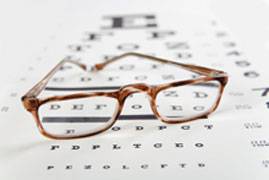Vision Health: What Is Age-Related Macular Degeneration?
Treatments may slow progression of vision loss disease

Treatments may slow progression of vision loss disease
It can begin with a barely noticeable loss of vision. Threading a needle may seem more difficult than before. The squares of a crossword puzzle may be harder to see. Over time, symptoms worsen and nearly all central vision may be lost.
It is a very common condition that affects many older adults: age-related macular degeneration (AMD).
Awareness of AMD has grown and so has the search for treatments, including at Scripps. No treatment can reverse AMD, but it can prevent the condition from worsening.
“If you experience blurry vision or difficulty recognizing faces, seek help right away. An eye doctor can check for AMD as part of an eye exam,” says Anne Hanneken, MD, an ophthalmologist at Scripps. “Treatment for AMD depends on stage and type.”
What is AMD?
AMD is the leading cause of severe vision loss in older adults. The number of cases is expected to increase as people continue to live longer.
AMD is an eye disease of the retina that causes the loss of central vision, which is used to see objects sharply and clearly. “Losing your central vision can affect everyday tasks, such as reading, driving and watching television,” Dr. Hanneken says. “While living with AMD can be challenging, there is help.”
AMD may develop in one or both eyes. It doesn’t affect peripheral vision, so complete vision loss is rare.
What causes AMD?
AMD affects the macula, a central part of the retina, the light-sensitive tissue in the back of the eye. The macula helps the eyes focus on things that require close, concentrated vision. AMD happens as the eye ages, leading to damage in the macula. It develops in stages.
In the early stages, small protein deposits build up under the cells that nourish the retina. Because these deposits cause no symptoms, patients are not aware of them.
Wavy straight lines can be a warning sign of AMD and can be monitored using an Amsler grid. This visual testing tool helps detect vision problems that may be caused by damage to the macula.
Types of macular degeneration
There are two types of macular degeneration: dry and wet form.
Dry AMD accounts for most cases. It occurs when light-sensitive cells in the macula slowly break down over time, leading to a gradual loss of central vision. In many cases, vision can remain stable for years.
Wet AMD is less common but can cause more rapid vision loss than dry AMD. Vision may change suddenly and include marked distortions and wavy lines, particularly affecting central field of vision. It happens when abnormal blood vessels grow under the retina and leak fluid or blood, which leads to scarring and damage of the macula.
Risk factors
Risk for AMD increases with age. People 55 and older are at higher risk for AMD. The risk is also higher for people who:
- Have a family history of AMD
- Are Caucasian
- Smoke
- Have high blood pressure
- Have a diet high on saturated fat
What are treatments for AMD?
There is no treatment for dry AMD, but help is available in case of vision loss, including low vision devices and vision rehab services to learn skills to live with low vision. Not everyone who has AMD experiences significant vision loss.
Standard treatments for wet AMD include medications called anti-VEGF drugs that block development of new blood vessels in the eye.
Studies show certain nutrients, taken through foods or supplements, may help slow progression of AMD, including:
- Vitamin C
- Vitamin E
- Copper
- Zinc
- Lutein
Supplements should complement not replace a diet rich in fruits, vegetables and leafy greens like spinach, kale and broccoli.
“Even after a diagnosis, you can take steps that may help slow vision loss. Among these are a healthy diet, keeping a healthy weight and exercising regularly,” Dr. Hannaken says. “These are like recommendations that would be made for cardiovascular disease. In fact, we think of dry age-related macular degeneration as sharing similar risk factors to cardiovascular disease.”
Other age-related vision loss conditions
AMD is just one of several common conditions that contribute to age-related vision loss. While AMD primarily affects central vision and the ability to spot in the center of vision, other conditions like cataracts, glaucoma and presbyopia impact different parts of the visual field.
Cataracts cloud the lens of the eye. This leads to blurry or dim vision. Surgery can treat cataracts.
Glaucoma harms the optic nerve. It often causes loss of peripheral vision.
Presbyopia makes it hard to focus on close objects. This happens because the lens becomes less flexible with age.
These conditions underscore why older adults should get regular eye exams. Early detection and treatment of age-related eye problems help preserve vision.